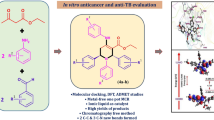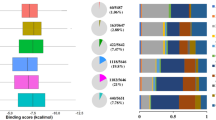Abstract
Human African trypanosomiasis, also known as sleeping sickness, is caused by the single-celled kinetoplastid parasite Trypanosoma brucei transmitted to humans by infected tsetse flies. The disease threatens millions of people. Currently available treatment options are faced with some important challenges. In this work, a total of eighty-seven (87) morpholine derivatives were evaluated for drug-likeness based on Lipinski’s rule of five and their ability to inhibit the activities of trypanosomal triosephosphate isomerase was assessed by molecular docking and calculation of free energy of binding. Analysis of the results revealed that 97.7 % of the dataset complied with Lipinski’s criteria for a molecule to be orally bioavailable. Also, 50.0 % of the studied compounds had a good total polar surface area profile, a parameter which is of great importance for the treatment of stage two Trypanosoma infections. Docking studies showed that all the dataset demonstrated affinity for triosephosphate isomerase. Moreover, six morpholines scored higher than the co-crystallized inhibitor of triosephosphate isomerase (2-phosphoglycerate). These derivatives inhibited the activity of triosephosphate isomerase by making significant interactions with Glu 167, Val 214, 233, Asn 11, Lys 13, Ser 213, Leu 232, Ile 172, Gly 211, 212, 234, 235 and His 92 in the active site of the protein. Furthermore, besides the acceptable pharmacokinetic profiles of the six morpholines, they also showed inhibitory potencies toward four other validated antitrypanosomal drug targets. In view of the foregoing findings, we propose that the six morpholine derivatives be given worthwhile attention to develop them into novel trypanocides.





Similar content being viewed by others
References
Asmaa HS (2013) Synthesis of some acetylenic morpholine derivatives via grignard reactions. Raf J Sci 24:31–38
Bakker BM, Michels PA, Opperdoes FR, Westerhoff HV (1997) Glycolysis in bloodstream for Trypanosoma brucei can be understood in terms of the kinetic of the glycolytic enzymes. J Biol Chem 272:3207–3215
Bakker BM, Michels PM, Opperdoes FR, Westerhoff HV (1999) What controls glycolysis in bloodstream form trypanosoma brucei? J Biol Chem 274:14551–14559
Berman HM, Westbrook J, Feng Z, Gilliland G, Bhat TN, Weissig H, Shindyalov IN, Bourne PE (2000) The protein data bank. Nucleic Acids Res 28:235–342
Caceres AJ, Michels PA, Hannaert V (2010) Genetic validation of aldolase and glyceraldehyde-3-phosphate dehydrogenase as drug targets in Trypanosoma brucei. Mol Biochem Parasitol 169:50–54
Canning P, Rea D, Morty R, Fulop V (2013) Ologopeptidase B from Trypanosoma brucei with covalently bound antipain-closed form. PLoS One 8:79349
Cao R, Chen CKM, Guo RT, Wang AHJ, Oldfield E (2008) Structures of a potent phenylalkyl bisphosphonate inhibitor bound to farnesyl and geranylgeranyl diphosphate synthases. Proteins 73:431–439
Chemical Computing Group (2010) Molecular Operating Environment (MOE) software
Chiarelli LR, Morera SM, Bianchi P, Fermo E, Zanella A, Galizzi A, Valentini G (2012) Molecular insight on pathogenic effects of mutations causing phosphoglycerate kinase deficiency. PLoS One 7(2):e32065
Choi J, Lee JO, Kim MS, Shin JEN, Chun KH (2008) Preparation of morpholine-2-one and 1,4-Oxazepan-2-one derivatives by cyclization reaction between N-Bts amino alcohol and chloroacetyl chloride. Bull Korean Chem Soc 29:1443–1444
Dion ME, Agler M, Milner JA (1997) S-allyl cysteine inhibits nitrosomorpholine formation and bioactivation. Nutr Cancer 28(1):1–6
Gao X, Maldonado E, Perez-montford R, Garza-Yamos G, De Gomez-Puyou MT, Gomez-Puyou A, Rodriguez-Romero A (1999) Crystal structure of triosephosphate isomerase from trypanosoma cruzi in hexane. Proc Natl Acad Sci USA 96:10062–10067
Ghose AK, Herbertz T, Hudkins RL, Dorsey BD, Mallamo JP (2012) Knowledge-based central nervous system (CNS) lead selection and lead optimization for CNS drug discovery. Neuroscience 3:50–68
Halgren TA (1996) Merck molecular force field. J Comput Chem 17:490–641
Henzi V, Reichling D, Helm S, MacDermott A (1992) L-proline activities glutamate and glycine receptors in cultured rat dorsal horn neurons. Mol Pharmacol 41:793–801
Hoet S, Opperdoes F, Brun R, Quetin-Leclercq J (2004) Natural products active against African trypanosomes: a step towards new drugs. Nat Prod Rep 21:353–364
Kaiser M, Bray MA, Cal M, Trunz BB, Torreele E, Brun R (2011) Antitrypanosomal activity of fexinidazole, a new oral nitroimidazole drug candidate for treatment of sleeping sickness. Antimicrob Agents Chemother 55:5602–5608
Klebe G (2006) Virtual ligand screening strategies; perspective and limitations. Drug Discov Today 11:580–594
Kubinyi H (1998) Structure-based design of enzyme inhibitors and receptors ligands. Curr Opin Drug Discov Dev 1:4–15
Kuettel S, Zambon A, Kaiser M, Brun R, Scapozza L, Perozzo R (2007) Synthesis and evaluation of antiparasitic activities of New 4-[5-(4-phenoxyphenyl)-2H-pyrazol-3-yl]morpholine derivatives. J Med Chem 50:5833–5839
Lipinski CA, Lombardo F, Dominy BW, Feeney PJ (1997) Experimental and computational approaches to estimate solubility and permeability in drug discovery and development settings. Adv Drug Deliv Rev 23:3–25
Matthew LL, Brandon RR, John PW (2009) A new strategy for the synthesis of substituted morpholines. J Org Chem 74:5107–5110
Nickbarg EB, Davenport RC, Petsko GA, Knowles JR (1988) Triosephosphate isomerase: removal of a putatively electrophilic histidine residue results in a subtle change in catalytic mechanism. Biochemistry 27:5948–5960
Ntie-Kang F, Lifongo LL, Judson PN, Sippl W, Efange SMN (2014) How “drug-like” are naturally occurring anti-cancer compounds? J Mol Model 20:2069
Ntie-Kang F, Nwodo NJ, Ibezim A, Simoben CV, Karaman B, Ngwa VF, Sippl W, Adikwu MU, Mbaze LM (2014) Molecular modeling of potential anticancer agents from African medicinal plants. J Chem Inf Model 54:2433–2450
Nurnabi M, Ismail M (2007) Synthesis of biologically important chiral morpholine derivatives. Bangladesh J Sci Ind Res 42:135–146
Nwaka S, Hudson A (2006) Innovation lead discovery strategies for tropical diseases. Nat Rev Drug Discov 5:942–955
Noble ME, Verlinde CL, Groendijk H, Kalk KH, Wierenga RK, Hol WG (1991) Crystallographic and molecular modeling studies on trypanosomal triosephosphate isomerase: a critical assessment of the predicted and observed structures of the complex with 2-phosphoglycerate. J Med Chem 34:2709–2718
Ogungbe IV, Setzer WN (2009) Comparative molecular docking of antitrypanosomal natural products into multiple Trypanosoma brucei drug targets. Molecules 14:1513–1536
Oprea TI (2002) Current trends in lead discovery: are we looking for the appropriate properties? J Comput Aided Mol Des 16:325–334
Palm K, Stenberg P, Luthman K, Artursson P (1997) Polar molecular surface properties predict the intestinal absorption of drugs n humans. Pharm Res 14:568–571
Sahin D, Bayrak H, Demirbas A, Demirbas N, Karaoglu SA (2012) Design and synthesis of new 1,2,4-triazole derivatives containing morpholine moiety as antimicrobial agents. Turk J Chem 36:411–426
Sanders WJ, Nienaber VL, Lerner CG, McCall JO, Merrick VL, Swanson SJ, Harlan JE, Stoll VS, Stamper GF, Betz SF, Condoski KR, Meadows RP, Severin JM, Walter KA, Magdalinos P, Jakob CG, Wagner R, Beutel BA (2004) DHNA complex with 2-amino-5-bromo-3-hydroxyl-6-phenylpyrimidine. J Med Chem 47:1709–1718
Setzer WN, Ogungbe VI (2012) In silico investigation of antitrypanosomal phytochemicals from Nigerian medicinal plants. PLoS Negl Trop Dis 6(7):e1727
Stuart KD, Brun R, Croft SL, Fairlamb AH, Gurtler RE, McKerrow JH, Reed S, Tarleton RL (2008) Kinetoplastids: related protozoan pathogens, different diseases. J Clin Invest 118:1301–1310
Teague SJ, Davis AM, Leeson PD, Opea TI (1999) The design of leadlike combinatorial libraries. Angew Chem Int Ed 38:3743–3748
World Health Organisation (2013) Fact sheet N°259: trypanosomiasis, human African (sleeping sickness). Accessed on 28 February 2015
Author information
Authors and Affiliations
Corresponding author
Ethics declarations
Conflict of interest
The authors declare that they have no competing interests.
Rights and permissions
About this article
Cite this article
Ibezim, A., Nwodo, N.J., Nnaji, N.J. et al. In silico investigation of morpholines as novel class of trypanosomal triosephosphate isomerase inhibitors. Med Chem Res 26, 180–189 (2017). https://doi.org/10.1007/s00044-016-1739-z
Received:
Accepted:
Published:
Issue Date:
DOI: https://doi.org/10.1007/s00044-016-1739-z




